The Facial Recognition Market is estimated to be valued at USD 8.1 billion in 2025 and is projected to reach USD 36.2 billion by 2035, registering a compound annual growth rate (CAGR) of 16.1% over the forecast period.
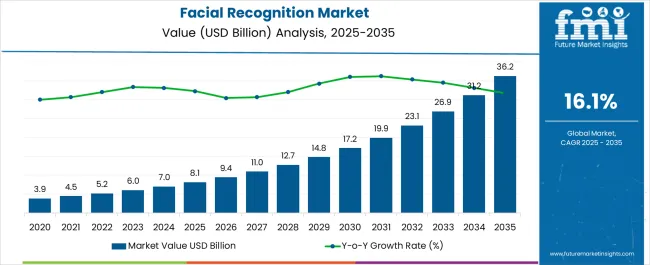
| Metric | Value |
|---|---|
| Facial Recognition Market Estimated Value in (2025 E) | USD 8.1 billion |
| Facial Recognition Market Forecast Value in (2035 F) | USD 36.2 billion |
| Forecast CAGR (2025 to 2035) | 16.1% |
The facial recognition market is expanding rapidly due to increasing demand for secure authentication, surveillance, and identity verification across industries. Growing adoption in financial services, government programs, and public safety initiatives is driving sustained investment in advanced recognition systems.
The integration of artificial intelligence and machine learning has significantly enhanced accuracy, speed, and scalability of recognition solutions, enabling widespread deployment in high security and consumer applications. Regulatory pushes for stronger security frameworks, coupled with the rise in digital transactions and smart city projects, are further reinforcing adoption.
The market outlook remains positive as organizations prioritize fraud prevention, streamlined customer verification, and efficient public safety measures, establishing facial recognition as a central component of modern digital infrastructure.
The market is segmented by Component, Vertical, and Application and region. By Component, the market is divided into Software Tools and Facial Analytics. In terms of Vertical, the market is classified into Banking, Retail & E-commerce, Automotive, Healthcare, Government & Defense, and Others. Based on Application, the market is segmented into Law Enforcement, Access Control, Emotion Recognition, Attendance Tracking and Monitoring, and Other Applications. Regionally, the market is classified into North America, Latin America, Western Europe, Eastern Europe, Balkan & Baltic Countries, Russia & Belarus, Central Asia, East Asia, South Asia & Pacific, and the Middle East & Africa.
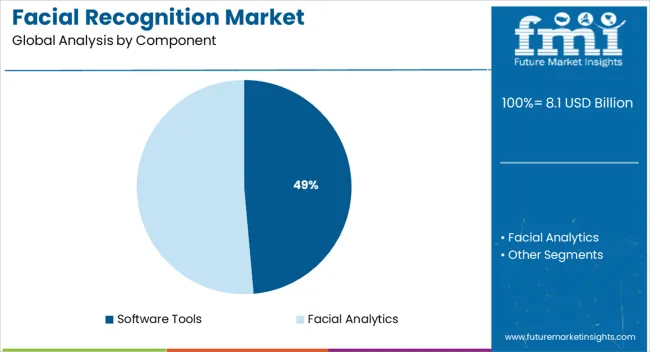
The software tools segment is expected to account for 48.60% of total market revenue by 2025 within the component category, making it the leading segment. Its growth is being driven by continuous improvements in algorithm accuracy, scalability across platforms, and integration with cloud based architectures.
Software solutions have enabled rapid deployment in both consumer devices and enterprise security frameworks. The ability to update and enhance systems through software upgrades without requiring significant hardware changes has also supported adoption.
As enterprises and public agencies focus on adaptable and cost effective recognition solutions, software tools continue to dominate the component landscape.
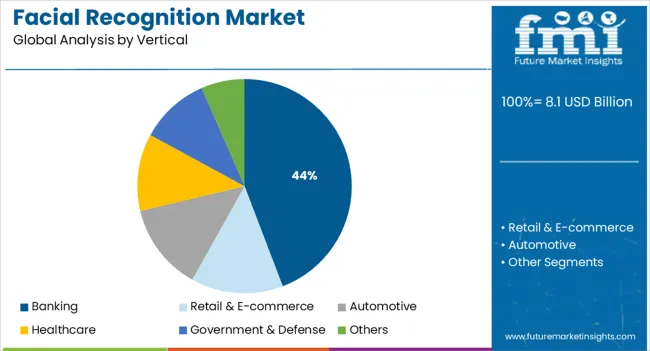
The banking segment is projected to contribute 44.20% of total revenue by 2025 within the vertical category, positioning it as the leading industry vertical. Growth is being fueled by rising incidences of financial fraud, identity theft, and the need for secure customer authentication across digital banking platforms.
Facial recognition has been deployed to streamline customer onboarding, enhance transaction security, and support compliance with regulatory mandates on biometric identification. The convenience of contactless verification and integration with mobile banking apps has further accelerated adoption.
As financial institutions continue prioritizing security while maintaining user experience, banking remains the largest vertical for facial recognition deployment.
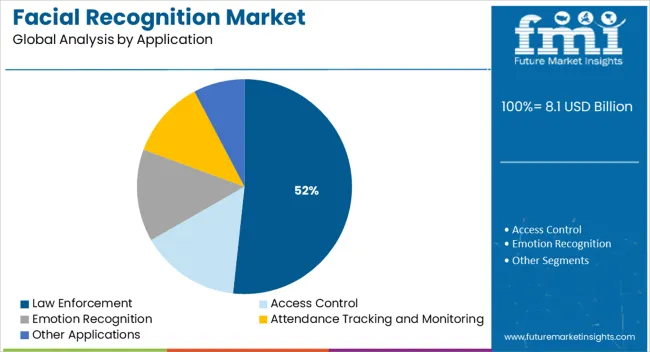
The law enforcement segment is expected to account for 51.70% of market revenue by 2025 within the application category, making it the dominant segment. The growth is being driven by heightened security concerns, increased need for surveillance in public spaces, and government investments in national security infrastructure.
Facial recognition is being leveraged for criminal identification, suspect tracking, and real time surveillance in urban centers. The technology’s ability to process vast amounts of data quickly and provide actionable intelligence has been recognized as critical in preventing and solving crimes.
As cities adopt smart surveillance systems and national agencies expand databases, law enforcement continues to represent the strongest application area for facial recognition technology.
With governments and private players investing in security, the demand for facial recognition systems is expected to surge during the forecast period. This coupled with the introduction of Artificial Intelligence and Machine Learning is expected to increase the efficiency of facial recognition systems.
The defense ministries are investing in facial recognition systems, as these are utilized in unmanned vehicles to select the right target. With an increasing number of sectors adopting the facial recognition system, their sales are slated to rise in the future.
This can be well explained by comparing the historical and anticipated CAGR. While the historical CAGR for the market was 10.9%, the anticipated CAGR has surged to 16.1%.
Facial recognition technology is used across industry verticals ranging from healthcare and retail to government and defense. Federal and police departments also use facial recognition technologies to catch suspected criminals in different cases. Even though the federal and police departments use this technology, the possibility of false matches poses a major problem.
For example, Boston's Logan Airport ran two separate facial recognition tests at its security checkpoints, using volunteers posing as terrorists over three months. Unfortunately, the results were disappointing. Throughout the testing period, the systems correctly identified the volunteers 153 times and failed to identify the volunteers 96 times. The high number of false alarms can result in the arrest of innocent people.
The arrest of innocent individuals could further lead to legal action against the concerned authorities. Hence, this also remains a major restraint in the implementation of facial recognition technology. Moreover, the lack of accuracy and high implementation cost of facial recognition technology hampers market growth.
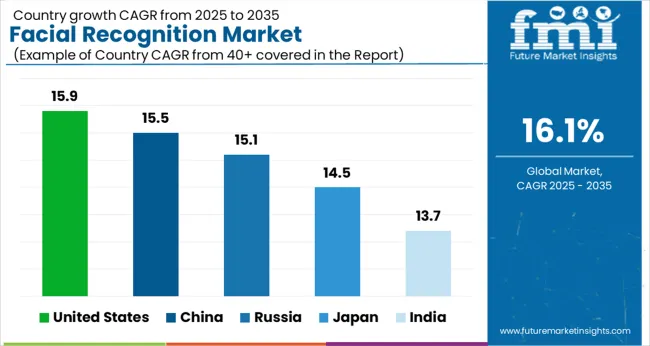
| Region | North America |
|---|---|
| Country | United States |
| CAGR (2025 to 2035) | 15.9% |
| Region | Asia Pacific |
|---|---|
| Country | Russia |
| CAGR (2025 to 2035) | 15.1% |
| Region | Asia Pacific |
|---|---|
| Country | China |
| CAGR (2025 to 2035) | 15.5% |
| Region | Asia Pacific |
|---|---|
| Country | Japan |
| CAGR (2025 to 2035) | 14.5% |
| Region | Asia Pacific |
|---|---|
| Country | India |
| CAGR (2025 to 2035) | 13.7% |
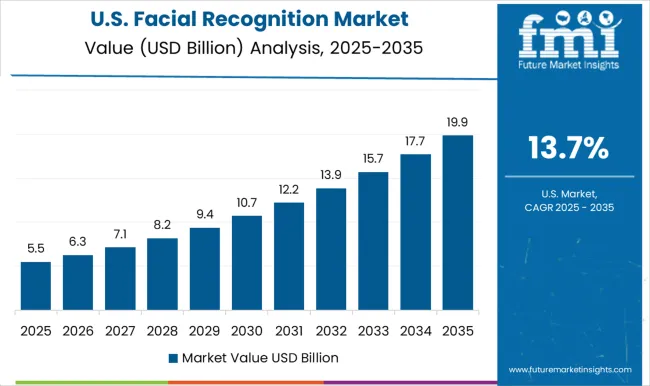
The United States is one of the technologically advanced countries. Apart from various niche areas, the facial recognition system is being used for citizen services as well. For several services, from security to convenience, the facial recognition system is used to determine the characteristics of the individual. The availability of the required infrastructure may assist the functioning of citizen services.
| Attributes | Details |
|---|---|
| United States Market Expected Size (2035) | USD 6.3 billion |
| United States Market Absolute Dollar Growth (USD million/billion) | USD 4.8 billion |
| CAGR % 2020 to 2025 | 10.5% |
The adoption of a facial recognition system for the financial system is expected to revolutionize the payments landscape. This service is expected to be available in all the major ATMs across the United States.
Russia currently ranks third in the world when it comes to defense capabilities. In 2025, Russia announced a defense budget of USD 84 billion. At a time when Russia is confronting Ukraine and is expected to have similar confrontations with a lot of other Western countries, the amount is expected to surge.
Owing to this, the Russia government is spending a huge amount on war drones. Not only local drones, but the Russia government is also buying drones from some countries, like Iran. The facial recognition system is an important aspect of these drones, as these assist in attacking the right target. These factors are expected to exponentially surge the sales of facial recognition systems.
| Attributes | Details |
|---|---|
| Russia Market Expected Size (2035) | USD 767.8 million |
| Russia Market Absolute Dollar Growth (USD million/billion) | USD 580 million |
| CAGR % 2020 to 2025 | 9.5% |
The sales of autonomous vehicles are gradually gaining pace in China. By 2035, the autonomous vehicles market in China is expected to cross a valuation of USD 100 billion. Surging technological advancements in the automobile sector and efforts to reduce carbon emissions are the driving factors. Autonomous vehicles make use of the facial recognition system to provide safety in case of car accidents.
| Attributes | Details |
|---|---|
| China Market Expected Size (2035) | USD 3.2 billion |
| China Market Absolute Dollar Growth (USD million/billion) | USD 2.4 billion |
| CAGR % 2020 to 2025 | 10.1% |
The Chinese hospitality sector is also making use of facial recognition technology to recognize guests and look up their reservations. These also assist in providing complimentary services to special guests.
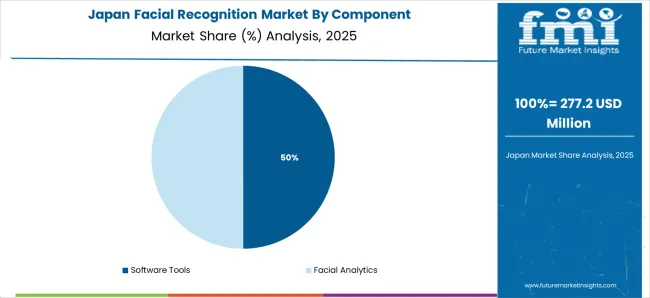
Japan's healthcare sector is considered one of the most advanced and technologically upgraded. For example, the Japanese healthcare system uses facial recognition to facilitate security. It makes use of an automated way of scanning if somebody enters the room.
Apart from that, it has also been assisting patients with fast check-in and check-out. As soon as the patient enters the hospital, the recognition system scans it against the available records. These are also used to clock the employee sign-in and sign-out timings.
| Attributes | Details |
|---|---|
| Japan Market Expected Size (2035) | USD 2.6 billion |
| Japan Market Absolute Dollar Growth (USD million/billion) | USD 1.9 billion |
| CAGR % 2020 to 2025 | 9% |
Being one of the dominant economies in the world, the Indian banking sector has shown growth by leaps and bounds. With massive technological advancements, it is expected that the KYC norms can be filled merely through a facial recognition system.
This is going to revolutionize the way banks work. Apart from that, the rapid penetration of mobile banking presents huge scope in front of the market.
| Attributes | Details |
|---|---|
| India Market Expected Size (2035) | USD 1.5 billion |
| India Market Absolute Dollar Growth (USD million/billion) | USD 1.1 billion |
| CAGR % 2020 to 2025 | 7.7% |
The country is also surrounded by adversaries. Thus, the facial recognition system is being used at border checkpoints, and through biometrics, the personnel can make out if the concerned person is a local or a trespasser.
| Segment | Component |
|---|---|
| Attributes | Software Tools |
| CAGR % 2020 to 2025 | 10.6% |
| CAGR % 2025 to 2035 | 15.8% |
| Segment | Vertical |
|---|---|
| Attributes | Government and Defense |
| CAGR % 2020 to 2025 | 10.4% |
| CAGR % 2025 to 2035 | 15.6% |
Software tools are expected to have the dominant market share. The software tools act as the interface between the hardware and the user, and provide a platform for analyzing the 2D/3D images. This solves the very purpose of understanding the image, and also makes use of various algorithms to derive a logical conclusion.
Apart from that, by making use of various Machine Learning techniques in the software, the precision of these software tools increases. These occupy a high market share owing to high application in defense and healthcare.
The government and defense segment is expected to hold the dominant share during the forecast period. This can be attributed to the high amounts being spent to upgrade military capabilities. Countries like China, the United States, etc. have been spending at least 10% of their GDP on upgrading their defense capabilities.
Apart from that, facial recognition systems are also being used in government offices for surveillance and identity purposes. Moreover, a lot of government offices are making use of biometrics to keep a database of all the crucial information of their employees.
The start-ups operating in the market have been developing platforms that offer computer vision technologies, which enable the applications to read and understand the world. This allows users to add deep learning-based image analysis recognition technologies with powerful Software Development Kits.
SenseTime: The start-up has been developing face recognition technology, which can be used for payment and picture analysis. These are used mainly for bank card verification and security systems. SenseTime is committed to advancing AI research, developing scalable AI software platforms, and nurturing top talents. SenseTime has raised a total of USD 7 billion in funding over 10 rounds. Their latest funding was in December 2024 from a Post-IPO Equity round.
The key players operating in the market are maintaining partnerships with key federal agencies worldwide to secure their crucial information. They are also providing biometrics solutions to a lot of federal agencies to maintain a secured database, and assist in employee recognition.
In January 2025, Aware was the trusted security enabler to 12 out of 15 executive departments within the executive branch.
Key developments in the market:
Dominant players in the market
| Company | Description |
|---|---|
| Aware | Aware has been the leading provider of biometrics software products, solutions, and services to empower users to own and control their identities. The identity verification and management solution supports financial solutions, enterprise security, law enforcement, and surveillance. Aware has always capitalized on its biometric domain expertise to ensure that the company delights users through a customer experience that leverages the cloud and emphasizes the ease of doing business. |
| Cognitec | Cognitec was founded in 2002 by a team of experts who recognized the growing demand for biometric software. The development of the products and growth of the company is built on the extensive knowledge of the scientists and software engineers. Cognitec has been into providing consulting services and excellent technical support as well. Cognitec employs a talented and dedicated team of experts in the areas of mathematics, software development, image processing, and pattern recognition technologies. |
| Fujitsu | Fujitsu has been making use of technology to make happier lives. The company is a global leader in technology and business solutions that transform organizations and the world. By bringing together integration capabilities and cutting-edge technologies, the company has been successful in advancing toward creating a sustainable world. By focusing on computing, network, Artificial Intelligence, Data and Security, and converging technologies, the company ensures consistency across the portfolio. |
Other companies profiled: Ayonix Corporation and FacePhi
The global facial recognition market is estimated to be valued at USD 8.1 billion in 2025.
The market size for the facial recognition market is projected to reach USD 36.2 billion by 2035.
The facial recognition market is expected to grow at a 16.1% CAGR between 2025 and 2035.
The key product types in facial recognition market are software tools, _2d facial recognition, _3d facial recognition, facial analytics, _facial recognition services, _training and consulting and _cloud based facial recognition.
In terms of vertical, banking segment to command 44.2% share in the facial recognition market in 2025.






Our Research Products

The "Full Research Suite" delivers actionable market intel, deep dives on markets or technologies, so clients act faster, cut risk, and unlock growth.

The Leaderboard benchmarks and ranks top vendors, classifying them as Established Leaders, Leading Challengers, or Disruptors & Challengers.

Locates where complements amplify value and substitutes erode it, forecasting net impact by horizon

We deliver granular, decision-grade intel: market sizing, 5-year forecasts, pricing, adoption, usage, revenue, and operational KPIs—plus competitor tracking, regulation, and value chains—across 60 countries broadly.

Spot the shifts before they hit your P&L. We track inflection points, adoption curves, pricing moves, and ecosystem plays to show where demand is heading, why it is changing, and what to do next across high-growth markets and disruptive tech

Real-time reads of user behavior. We track shifting priorities, perceptions of today’s and next-gen services, and provider experience, then pace how fast tech moves from trial to adoption, blending buyer, consumer, and channel inputs with social signals (#WhySwitch, #UX).

Partner with our analyst team to build a custom report designed around your business priorities. From analysing market trends to assessing competitors or crafting bespoke datasets, we tailor insights to your needs.
Supplier Intelligence
Discovery & Profiling
Capacity & Footprint
Performance & Risk
Compliance & Governance
Commercial Readiness
Who Supplies Whom
Scorecards & Shortlists
Playbooks & Docs
Category Intelligence
Definition & Scope
Demand & Use Cases
Cost Drivers
Market Structure
Supply Chain Map
Trade & Policy
Operating Norms
Deliverables
Buyer Intelligence
Account Basics
Spend & Scope
Procurement Model
Vendor Requirements
Terms & Policies
Entry Strategy
Pain Points & Triggers
Outputs
Pricing Analysis
Benchmarks
Trends
Should-Cost
Indexation
Landed Cost
Commercial Terms
Deliverables
Brand Analysis
Positioning & Value Prop
Share & Presence
Customer Evidence
Go-to-Market
Digital & Reputation
Compliance & Trust
KPIs & Gaps
Outputs
Full Research Suite comprises of:
Market outlook & trends analysis
Interviews & case studies
Strategic recommendations
Vendor profiles & capabilities analysis
5-year forecasts
8 regions and 60+ country-level data splits
Market segment data splits
12 months of continuous data updates
DELIVERED AS:
PDF EXCEL ONLINE
Facial Recognition Machine Market
Facial Serum Market Forecast and Outlook 2025 to 2035
Facial Care Products Market Size and Share Forecast Outlook 2025 to 2035
Facial Mask Maker Market Size and Share Forecast Outlook 2025 to 2035
Facial Erythema Treatment Market Size and Share Forecast Outlook 2025 to 2035
Facial Oil Market Analysis by Product Type, End User, Sales Channel and Region Through 2025 to 2035
Facial Tissue Paper Market Analysis - Trends, Growth & Forecast 2025 to 2035
Facial Steamer Market - Trends, Growth & Forecast 2025 to 2035
Facial Pumps Market Growth – Demand & Forecast 2025 to 2035
Facial Tracking Solution Market by Component, Technology Type, Industry & Region Forecast till 2035
Facial Tissue Market Growth – Size, Demand & Forecast 2024-2034
Facial Epilator Market Analysis – Size, Trends & Forecast 2024-2034
Facial Implants Market
Bifacial Solar Module Market Size and Share Forecast Outlook 2025 to 2035
Craniofacial Implants Market Size and Share Forecast Outlook 2025 to 2035
Electric Facial Cleansing Brush Market Size and Share Forecast Outlook 2025 to 2035
Chelating Facial Masks Market Analysis - Size and Share Forecast Outlook 2025 to 2035
Gluten-Free Facial Product Market Trends – Growth & Forecast 2024-2034
Cranial And Facial Implants Market
Craniomaxillofacial Devices Market Size and Share Forecast Outlook 2025 to 2035

Thank you!
You will receive an email from our Business Development Manager. Please be sure to check your SPAM/JUNK folder too.
Chat With
MaRIA